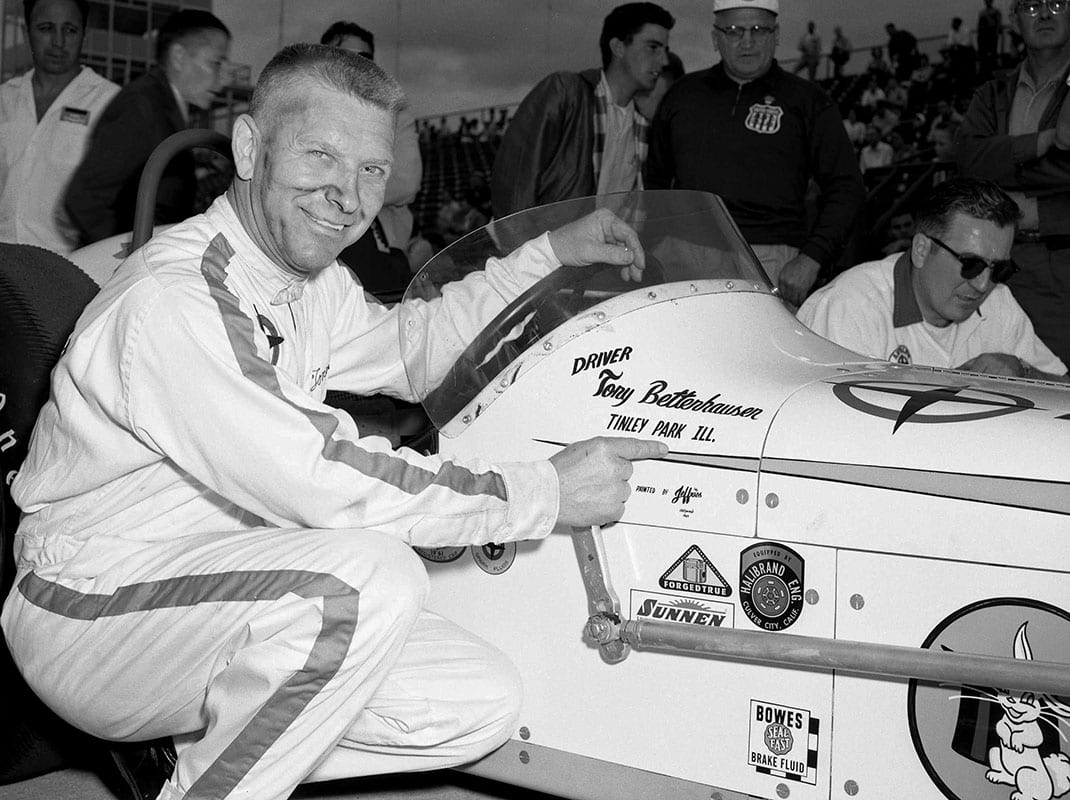Bettenhausen wrecked the Belanger No. 99 attempting to qualify for the Indianapolis 500 in 1952. Escaping serious injury, Bettenhausen bounced off the south wall a reported three times. A week after the big race, Bettenhausen announced he was retiring from all racing except the Indianapolis 500 – partially influenced by the death of Johnny McDowell at Milwaukee. He previously announced his retirement from all racing in 1948 exclusively to Chicago area motorsports writer Wayne Adams as he laid in the hospital, recuperating from serious leg burns he suffered when a gas line broke in his midget at DuQuoin, Ill.
Recovered from serious injuries received in a midget crash at Chicago’s Soldier Field in 1954, Bettenhausen turned in his best Indianapolis 500 performance in 1955 when he and co-driver Paul Russo guided H.A. Chapman’s No. 10 to a second place finish with the duo winning $30,089. Bettenhausen and his old “Chicago Gang” buddy Russo had planned the co-driving before the race with Bettenhausen starting the race in second position.
Bettenhausen joined forces again with Belanger for the 1956 race. Bettenhausen started fifth in Belanger’s Kurtis roadster only to hit the wall after blowing a tire and breaking a collarbone. He completed 160 laps and was credited with 22nd in the finishing order. Bettenhausen was 15th in 1957 behind the wheel of the powerful Novi racer.
Bettenhausen put together two fourth places finishes in both 1958 and 1959 in Quin Epperly-built laydown roadsters. He crashed hard at Indy in 1959 during practice but came back in another car to qualify for the race. Although not winning a single race in 1958, Bettenhausen was again the National Champion. Driving for Lindsey Hopkins in 1960, Bettenhausen finished 23rdin his Dowgard Special No. 2 after dropping out because of a broken connecting rod.

Caring for some 600 acres of corn and soybeans at his farm in Tinley Park, Bettenhausen had talked Hopkins into buying a year-old, Quin Epperly-built laydown roadster for the Indianapolis 500 in 1961. Autolite would be the sponsor with veteran crew chief Jack Beckley handling the wrenches. When the speedway opened in early May, Bettenhausen in his Autolite Special No. 5 established himself as a heavy race favorite. He was fast when things got underway, turning a lap of 149.254 mph on May 10 – the Wednesday before the first weekend of time trials.
“I’m just warming this baby up,” said Bettenhausen, who was flirting with the magical 150 miles-per-hour lap. “If it went 149 that easy today, I’ll make it 150 by Saturday. I’m confident that I’ll get that 150-mile-an-hour lap.”
On Friday afternoon. May 12, the 44-year-old Bettenhausen would take a few practice laps in buddy Paul Russo’s car as he attempted to help Russo find some needed speed. Coming down the main straightaway, just the passed the start/finish line, the car abruptly turned right, crashing and sliding upside down along the outside retaining wall 100 yards or so, taking out six sturdy fence posts and being wrapped in protective fencing during its sickening journey. An anchor bolt holding the front radius rod support fell out causing the car to turn sharply when the brakes were applied. A fire broke out but the “Tinley Park Express” was already beyond help.
Looking back at his career, Bettenhausen, whose sons, Gary, Merle and Tony, would follow their Dad’s racing footsteps, had started 118 AAA/USAC championship races, winning 22 of them. He posted 30 more top-five finishes and had won 13 pole positions. Bettenhausen was also a winner in national midget and stock car competition and even competed in the Mexican Road Race twice. Tony Bettenhausen was a favorite during what many consider a very special era of auto racing.
